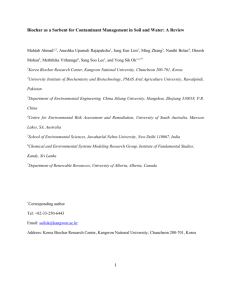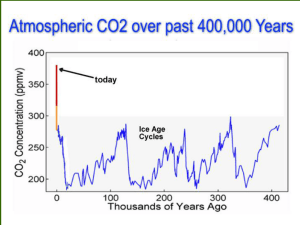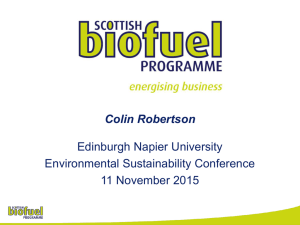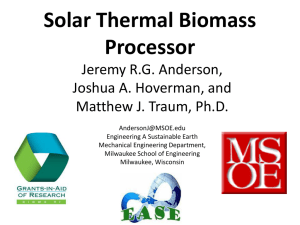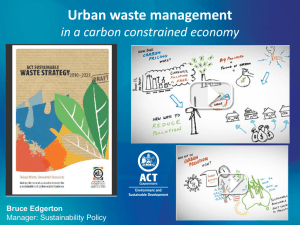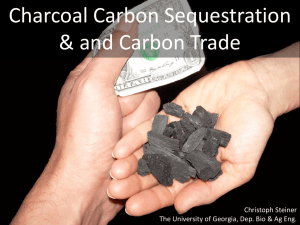Productivity and cost analysis of a mobile pyrolysis system deployed
advertisement
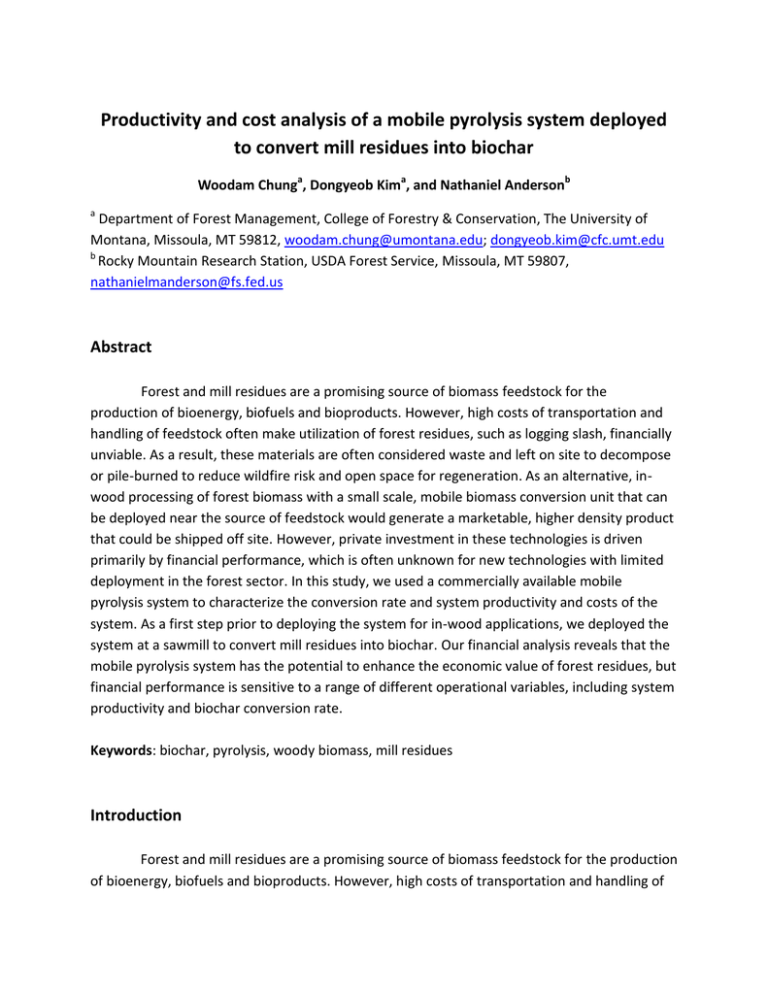
Productivity and cost analysis of a mobile pyrolysis system deployed to convert mill residues into biochar Woodam Chunga, Dongyeob Kima, and Nathaniel Andersonb a Department of Forest Management, College of Forestry & Conservation, The University of Montana, Missoula, MT 59812, woodam.chung@umontana.edu; dongyeob.kim@cfc.umt.edu b Rocky Mountain Research Station, USDA Forest Service, Missoula, MT 59807, nathanielmanderson@fs.fed.us Abstract Forest and mill residues are a promising source of biomass feedstock for the production of bioenergy, biofuels and bioproducts. However, high costs of transportation and handling of feedstock often make utilization of forest residues, such as logging slash, financially unviable. As a result, these materials are often considered waste and left on site to decompose or pile-burned to reduce wildfire risk and open space for regeneration. As an alternative, inwood processing of forest biomass with a small scale, mobile biomass conversion unit that can be deployed near the source of feedstock would generate a marketable, higher density product that could be shipped off site. However, private investment in these technologies is driven primarily by financial performance, which is often unknown for new technologies with limited deployment in the forest sector. In this study, we used a commercially available mobile pyrolysis system to characterize the conversion rate and system productivity and costs of the system. As a first step prior to deploying the system for in-wood applications, we deployed the system at a sawmill to convert mill residues into biochar. Our financial analysis reveals that the mobile pyrolysis system has the potential to enhance the economic value of forest residues, but financial performance is sensitive to a range of different operational variables, including system productivity and biochar conversion rate. Keywords: biochar, pyrolysis, woody biomass, mill residues Introduction Forest and mill residues are a promising source of biomass feedstock for the production of bioenergy, biofuels and bioproducts. However, high costs of transportation and handling of feedstock often make utilization of forest residues, such as logging slash, financially unviable. In general, higher transportation costs resulting from low local and regional demand for residues negatively impact the financial viability of forest operations by potentially turning previously marketable byproducts into waste materials with disposal costs. Despite its challenges, some mills in the Rocky Mountain region have responded to shrinking residue markets by integrating the production and marketing of value-added products traditionally made from forest and mill residues, including landscaping materials, animal bedding, compost, and wood pellets. Others have explored options for using biochemical or thermochemical conversion technologies to produce liquid biofuels, chemicals, and other high-value bioproducts (Briens 2008). Depending on the feedstock used and the substitutability of end products, these outputs have potential to offset fossil fuel use and associated emissions with renewable forest resources. Furthermore, they can improve energy security by displacing imported fuels and petrochemicals with domestic biomass energy products. A large body of research is devoted to laboratory and pilot scale study of thermochemical conversion of woody biomass (Mohan et al. 2006, Kumar et al. 2009, van der Stelt et al. 2011), and an increasing number of companies are developing and marketing commercial technologies for biomass conversion. Especially, several companies manufacture distributed-scale conversion systems that can be deployed near the source of feedstock to avoid long haul transportation of bulky woody biomass (e.g., Biochar Solutions 2011). For forest industry firms, the decision to invest in a thermochemical conversion system for processing residues, however, hinges on the cost structure and financial performance of such an operation. Unfortunately, there is a high degree of uncertainty related to the performance of these systems and little market data to inform the marketing of their outputs, especially for biochar and bio-oil. This is primarily due to the fact that distributed pyrolysis systems are not yet widely deployed in industrial settings, resulting in a lack of economic data and market transactions for products. Existing studies tend to rely on theoretical production estimates rather than empirical data collected during manufacturing operations (e.g., Sorenson 2010, Badger et al. 2011, Brown et al. 2011). To date, no study has examined the use of distributed-scale thermochemical conversion using work study methods to quantify costs, productivity, and financial performance. The objective of this study is to evaluate a commercially available system in the context of co-locating with forest industry operations. Specifically, we: (1) observed a mobile pyrolysis reactor operating at a sawmill in Colorado, (2) collected shift-level production data to characterize conversion rate and system productivity and costs, and (3) evaluated the net present value (NPV) of the operation in light of a cost structure that is realistic for the industry . This critical new knowledge is needed by technology firms, investors, and managers to evaluate the potential costs and benefits of integrating distributed-scale thermochemical processing systems into existing operations. Methods In this study, we used a small scale mobile pyrolysis system manufactured by Biochar Solutions Incorporated (BSI, Carbondale, CO). The system was engineered to produce biochar from biomass including agricultural residues and wood waste. This small-scale mobile pyrolysis system produces biochars with high fixed carbon content and high sorption using an exothermic reaction at temperatures between 350 and 750 °C. Energy gas and heat are generally considered co-products of biochar production. Though a fraction of the gas stream could technically be condensed into bio-oil, the system does not produce a liquid output. Data collection and productivity study A system productivity study was designed to evaluate the production and financial performance of a BSI mobile pyrolysis system deployed at a sawmill in Pueblo, CO. Data collection was carried out at the site for 25 working days in October and November, 2011. Two different types of mill residues were used as feedstock in thermochemical biomass conversion: green mixed conifer mill residues and beetle-killed mill residues. Mixed conifer mill residues were composed of ponderosa pine (Pinus ponderosa, 90%) and other conifer tree species (10%), such as Douglas fir (Pseudotsuga menziesii). Beetle-killed mill residues were produced from beetle-killed lodgepole pine (Pinus contorta) harvested from White River National Forest in northwest Colorado. Both mill residues were preprocessed prior to the conversion through chipping, grinding, and screening to less than 3-inch particle size. The BSI pyrolysis system was operated by either one or two operators in one 8-hour shift per day during the 25-day study period. The system was started in the morning by turning on the blower and initiating combustion in the first stage reactor with a propane torch. After startup, system operation typically included four steps: feedstock loading, feedstock conveying and drying, thermochemical conversion, and biochar collection. First, a front end wheeled loader is used to load preprocessed feedstock into a hopper. Feedstock is then slowly moved into the reactor through a conveyor system, while being dried by heat generated from a thermal oxidizer exhaust stack. The reactor converts feedstock into biochar, which is collected into barrels in two different forms: coarse biochar from a liquid cooled auger and dust removed from the gas stream by a cyclone. To estimate the system productivity, we collected shift-level time study data during operation including start time, end time, weather conditions, and delays. Start time was measured when the system blower was turned on at the beginning of each shift, and end time was measured when the entire system was shut down and the operators left the site. In our study, delays were defined as any break times longer than 10 minutes in blower operation, with an assumption that the system does not produce biochar when the blower is off. To estimate system productivity and conversion rate on per unit weight basis, the total weight of feedstock was measured using an in-ground certified platform truck scale at the site at the beginning of each shift and the weight of biochar chips and dust output in barrels was measured using an electronic floor scale. In addition, the pressure and temperature of reactors and gas-paths of the BSI system were monitored and recorded with a computer system during the operation. Productivity and biochar conversion rate are important measures of pyrolysis system performance. In this study, we define shift-level productivity as a ratio of the amount of feedstock consumed during the shift in green-tons (gt) to productive machine hours (PMH, abbreviated pmh in units). Gross level productivity of the system can be then estimated by compiling shift-level data for the entire field study period. We calculated productivity on a PMH basis instead of using scheduled machine hours (SMH), because the BSI pyrolysis system used in this study is an early design, and stable utilization rates have not been established for the system. In addition, our productivity measure is based on the amount of feedstock consumption rather than biochar production because several cost factors considered in the financial analysis depend on feedstock characteristics, such as feedstock loading and preprocessing costs, and because feedstock throughput is an important metric when considering pyrolysis systems for management of biomass byproducts, including mill residues. Conversion rate was defined as a mass ratio of the total produced biochar to the total consumed feedstock during the field production. The total amount of produced biochar includes biochar chips and dust, which are both marketable products of the operation. Calculating machine rates and operation costs We estimated pyrolysis system costs on a dollar per green-ton of feedstock basis using costs broken into three operational categories: feedstock preparation, pyrolysis conversion, and biochar bagging. Feedstock preparation includes feedstock grinding, screening and loading operations. Each operation requires the use of machinery, such as a tub grinder, rotary screener, loader, pyrolysis system, and biochar bagging equipment. The cost of each operation can be then estimated using a standardized machine hourly cost (i.e., machine rate) required for the operation, and machine productivity. To calculate machine rates for individual machines used in the pyrolysis operations, we used widely accepted standard methods for machine rate calculations (Brinker et al. 2002). We obtained the machine rate parameters for a tub grinder and a wheel loader from the default values suggested in the Forest Residue Trucking Simulator v 5.0 (FoRTS v 5.0; USDA Forest Service 2012), while the price of the screener was obtained from the machine owner. For the BSI pyrolysis system, most machine rate parameters were obtained from the manufacturer’s suggestions except for the PMH per year of the machine. We assumed the machine would productively operate for 8 hours a day and 260 days per year. For machine productivity, the default values from FoRTS v.5 were used for a tub grinder and a wheel loader, which are 15 gt pmh-1, 60 gt pmh-1, respectively. For the screening equipment, a productivity of 15 gt pmh-1 was used as the operator’s estimate. The productivity of the BSI pyrolysis system observed during the field study was used in the cost calculation. Biochar bagging costs were estimated based on the pyrolysis system owner’s suggestion, which was $40 yard-3 for bagging operation costs and $10 for each cubic yard bulk bag. To be consistent with other cost measures, these bagging operations costs were converted into dollar per green-ton of feedstock using conversion rate and biochar density observed during the field study. Results and Discussion BSI pyrolysis system productivity During a total of 25 days of our field study, the pyrolysis system was productive for 22 days and undergoing maintenance for 3 days due to unexpected mechanical problems. We did not include this unexpected maintenance period in our productivity analysis. Total hours worked during 22 working days were 167.0 hours ranging from 3.8 to 10.2 hours per working day or an average of 7.6 hours per shift. Hours worked in each shift varied depending on operators’ working schedules, pyrolysis system performance, and weather conditions. The system operated in the open, and was not operated during heavy rain or snow. There were a total of 31.4 hours of delays recorded during 22 working days with an average of 1.4 hours of delay per shift. Most delays were mechanical problems such as reactor clogging and auger malfunction. A total of 23.4 gt of feedstock were consumed during the field study, while a total of 3.3 tons of biochar was produced, for an observed conversion rate of 14.1% by mass. The biochar production amount includes both biochar chips and dust. During the field study, we were able to measure the weight of biochar chips produced at the end of each shift, but biochar dust was measured only when the dust-collecting barrel was removed from the system and replaced, normally once every 2 to 3 shifts. To estimate the shift-level biochar dust production, we calculated a ratio of dust to chips using the gross amount of production of each product, and then multiplied the ratio (0.315) by shift-level biochar chip production. Based on the observed gross feedstock consumption and productive work hours over the 22 working days, the productivity of the BSI pyrolysis system is estimated as 0.172 gt pmh-1. The shift-level productivity ranged from 0.126 to 0.241 gt pmh-1. This wide variation in shift-level productivity indicates that the system did not run consistently during the observation period, probably due to mechanical reactor clogging that was not recorded as delay. Costs of pyrolysis operation Machine rates estimated for a tub grinder, a rotary screener, and a wheel loader used for feedstock preparation are $163.81, $39.78, and $78.86 pmh-1, respectively. The machine rate of the BSI pyrolysis system is $48.07 pmh-1. Total feedstock preparation costs are estimated as $14.88 gt-1 of feedstock. Among the three individual operations of feedstock preparation, grinding is the most expensive component, accounting for 73% of the total feedstock preparation costs. The cost of pyrolysis conversion using the BSI system is estimated as $279.48 gt-1 based on the system machine rate and observed system productivity. Biochar bagging cost is estimated as $59.87 gt-1. In the bagging cost calculation, a biochar density of 0.141 g cc-1 (Anderson et al. 2012) and a conversion rate of 14.1% are used. In summary, the total cost of the entire pyrolysis operation for biomass-to-biochar conversion is estimated as $354.23 gt-1, and the conversion process is the most expensive component of the operation, accounting for 79% of the total cost. Conclusions A mobile pyrolysis system was successfully deployed to a sawmill and used to process mill residues into biochar. Results show that at the productivity and conversion rates observed, this system might not be financially viable as a stand-alone enterprise. However, empirical data and observation of the system show clear opportunities for technical and operational improvements that could increase the productivity of this system, many of which have already been undertaken by the companies cooperating in this research. The pyrolysis system used in this study is a small-scale conversion system designed for mobility, and can be easily trailer mounted. We believe future studies should also investigate in-woods applications of the system. With enhanced consistency in operation and higher productivity, the system has the potential to improve the utilization of forest residues that would otherwise be burned in place. Acknowledgements The authors would like to thank Biochar Solutions Incorporated and Pueblo Wood Products, especially Jonah Levine and Brad Dunmire, for participating in this study and generously providing time, resources, and information. Dan McCollum, Dan Loeffler, and Edward Butler assisted with field operations and data collection. This research was funded by a Woody Biomass, Bioenergy, and Bioproducts grant from U.S. Forest Service Research and Development, with significant cost match and in-kind support from the University of Montana, Biochar Solutions Incorporated, and Pueblo Wood Products. Literature Cited Briens C, Piskorz J, Berruti F. Biomass valorization for fuel and chemicals production - a review. Int J Chem Reactor Eng 2008;6(1):-. Anderson N, Page-Dumroese D, Jones JG, McCollum D, Baker S, Loeffler, D. A comparison of producer gas, biochar, and activated carbon from two thermochemical conversion systems used to process forest biomass. Biomass and Bioenergy in review; -. Mohan D, Pittman Jr C, Steele P. Pyrolysis of wood/biomass for bio-oil: a critical review. Energy Fuels 2006;20:848-89. Kumar A, Jones D, Hanna M. Thermochemical biomass gasification: a review of the current status of the technology. Energies 2009;2(3):556-81. van der Stelt M, Gerhauser H, Kiel J, Ptasinski K. Biomass upgrading by torrefaction for the production of biofuels: a review. Biomass Bioenerg 2011;35:3748-62. Biochar Solutions, Incorporated (BSI). BSI biochar base unit: technical specifications v 3.0; 2011. Sorenson CB. A comparative financial analysis of fast pyrolysis plants in Southwest Oregon [dissertation]. Missoula (MT): University of Montana; 2010. Badger P, Badger S, Puettmann M, Steele P, Cooper J. Techno-economic analysis: preliminary assessment of pyrolysis oil production costs and material energy balance associated with a transportable fast pyrolysis system. Bioresour 2011;6(1):34-47. Brown AL, Brady PD, Mowry CD, Borek TT. An economic analysis of mobile pyrolysis for Northern New Mexico forests. Albuquerque (NM): Sandia National Laboratories, US DOE; 2011 Dec. Report No.: SAND2011-9317. Forest Operations Research Unit, USDA Forest Service [Internet]. Auburn, AL; 2005. Forest Residue Trucking Simulator (FoRTS) v. 5. Available from: http://www.srs.fs.usda.gov/forestops/tools.html [last accessed on 6/7/2012]
